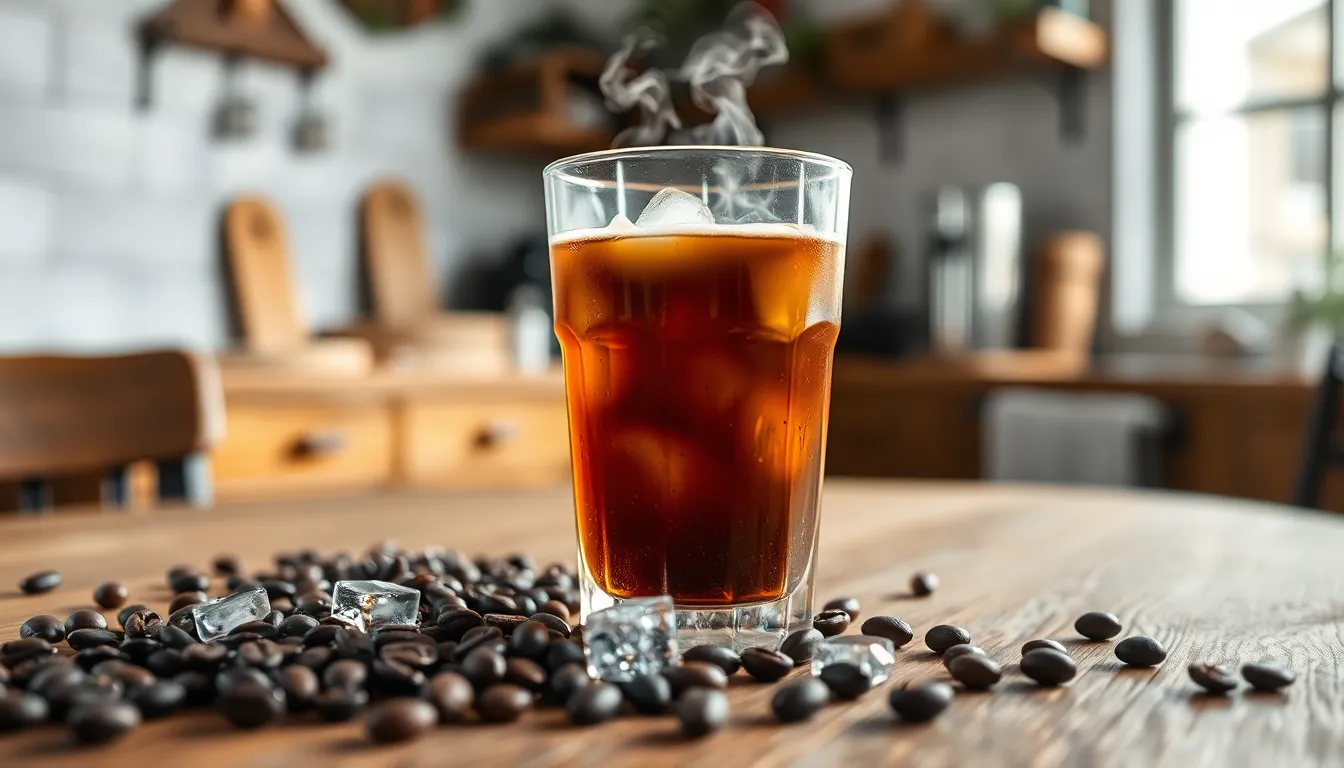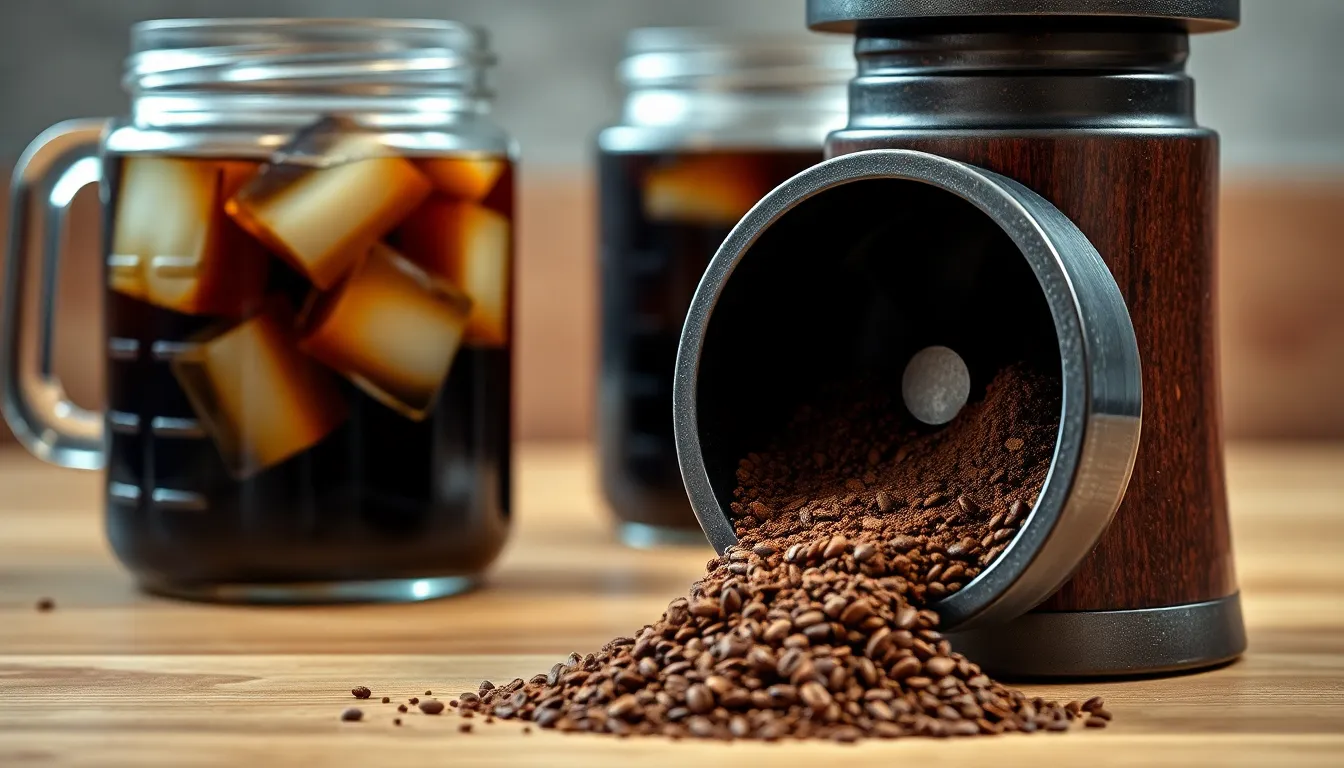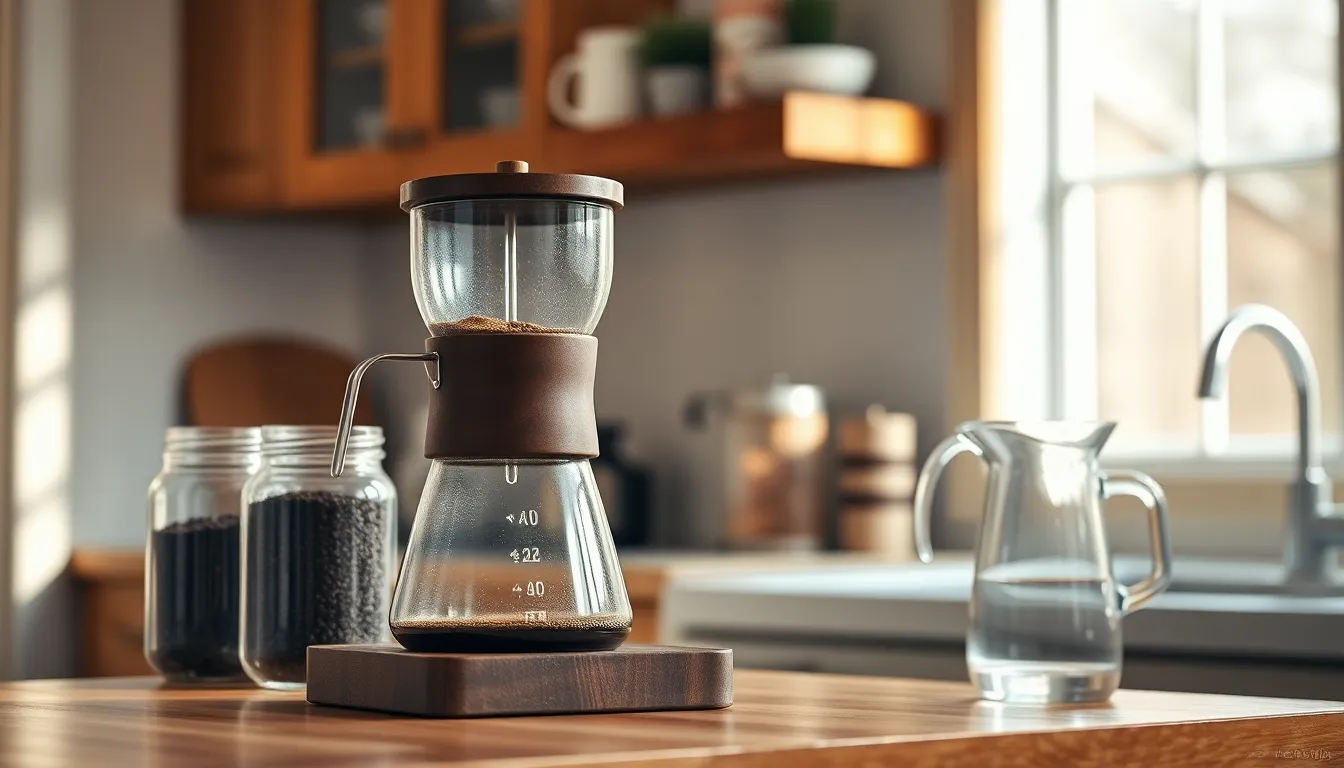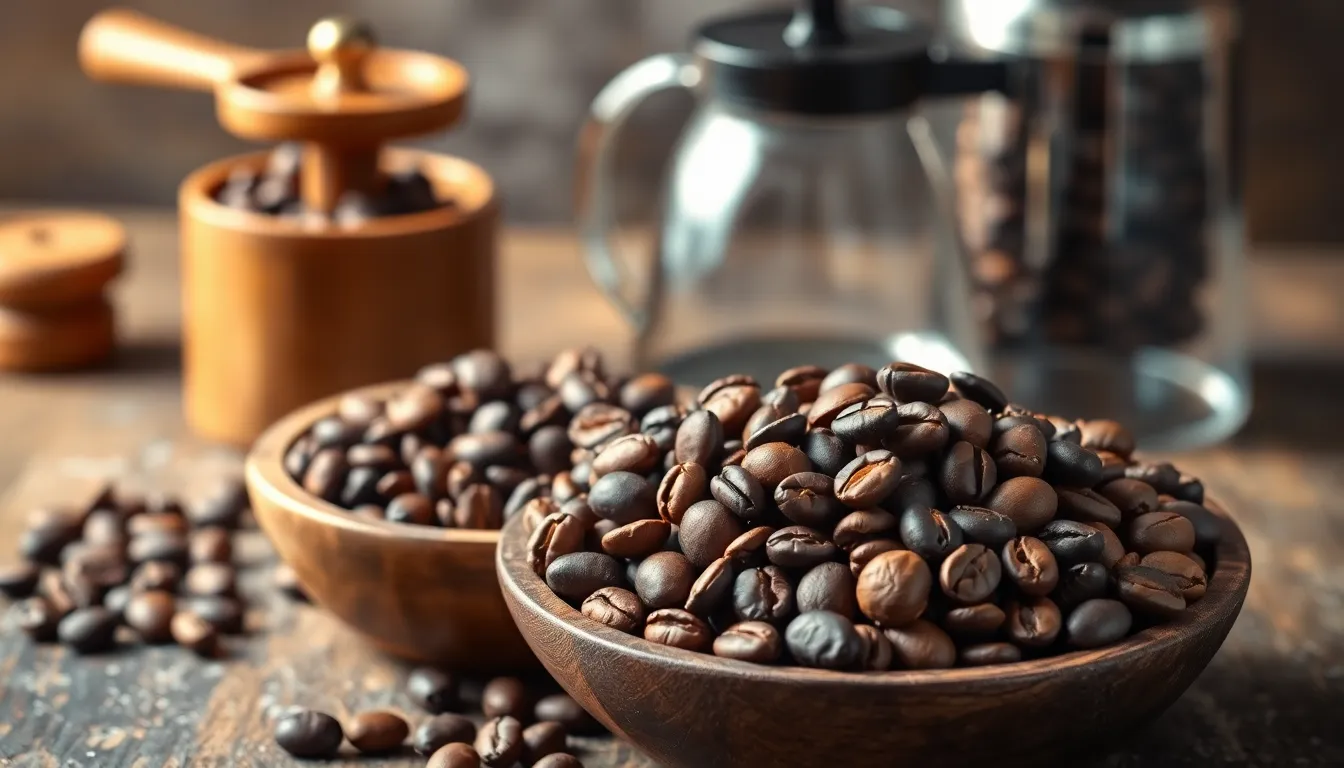Looking for the best coffee for cold brew but feeling overwhelmed by options? The perfect cold brew starts with selecting the right beans—it’s the foundation that determines whether your homemade creation will be exceptional or merely average.
Cold brew requires exact coffee characteristics to shine. Unlike hot brewing methods, cold brew’s slow extraction process pulls different flavor compounds from the beans, making your coffee choice even more critical. The right beans will deliver that smooth, sweet, low-acid profile that cold brew lovers crave, while the wrong ones might leave you with a flat, underwhelming experience.
What Makes Coffee Ideal for Cold Brew
The ideal cold brew coffee possesses exact characteristics that complement the slow extraction method. Cold brewing highlights different flavor compounds than hot brewing, making certain bean attributes more desirable for this preparation style.
The Importance of Roast Level
Roast level significantly impacts cold brew’s flavor profile and overall experience. Medium to dark roasts typically perform best in cold brew, offering chocolatey, nutty, and caramel notes that shine through the cold extraction process. Light roasts, while excellent for pour-overs, often produce thin-tasting cold brew lacking the rich mouthfeel most people enjoy. Rikki Manny, who’s been experimenting with cold brew for over a decade, found that medium-dark roasts consistently produce the most balanced and satisfying results. Many customers report that very dark roasts can introduce unwanted bitterness even in cold brew, even though the method’s reputation for reducing acidity.
Bean Origin Considerations
Coffee origin dramatically affects your cold brew’s flavor complexity and character. Single-origin beans from regions like Colombia, Guatemala, and Brazil often create exceptional cold brew due to their balanced acidity and pronounced chocolate notes. Ethiopian beans contribute interesting fruity and floral dimensions but require careful brewing to prevent overwhelming brightness. “I’ve noticed my customers gravitate toward Brazilian beans for their first cold brew experience,” Rikki explains. “They’re consistently smooth with those chocolate and nut flavors that work beautifully in cold extraction.” Central American beans offer excellent middle-ground options with their balanced profiles featuring moderate acidity and medium body that translate well to cold brew. Southeast Asian varieties like Sumatran beans deliver earthy, spicy profiles with substantial body, creating distinctive cold brews with remarkable depth.
Top 10 Best Coffees for Cold Brew

Cold brew coffee shines with beans that produce smooth, rich flavors during the long steeping process. The following selections represent the finest coffee options across different roast profiles, each offering unique characteristics that enhance your cold brew experience.
Light Roast Options
Light roasts aren’t typically the first choice for cold brew due to their higher acidity and lighter body. Ethiopian Yirgacheffe stands out as an exceptional light-to-medium roast option for cold brew enthusiasts seeking brighter profiles. This coffee delivers distinctive fruity and floral notes that create a vibrant cold brew experience. The delicate complexity of Ethiopian beans transforms during the cold extraction process, resulting in a refreshing cup with subtle sweetness that’s perfect for summer mornings.
Medium Roast Selections
Medium roasts provide the perfect balance for cold brew, offering rich flavor without overwhelming bitterness. Colombian Supremo ranks among the top choices with its chocolate and caramel notes that shine through in cold brew preparations. The full-bodied profile of Colombian beans maintains its integrity even when diluted with milk or ice, making it a versatile and affordable option for everyday cold brewing.
Guatemala Antigua offers another excellent medium-dark roast option with distinctive chocolate undertones complemented by subtle spice notes. These beans develop remarkable complexity during the cold brew process, extracting rich flavors that create a smooth, well-rounded cup. Many cold brew fans appreciate how Guatemalan coffee provides both depth and nuance without the acidity that can sometimes appear in lighter roasts.
Dark Roast Favorites
Dark roasts excel in cold brew applications, producing bold, low-acid concentrates with pronounced chocolate and nutty characteristics. Brazilian Santos delivers a consistently smooth cold brew experience with prominent cocoa and nut flavors that create a satisfying richness. The natural sweetness of these beans becomes amplified during cold extraction, requiring minimal additives for an enjoyable drink.
Sumatra Mandheling represents another dark roast standout, known for its distinctively earthy and full-bodied profile. These Indonesian beans create intensely flavored cold brew with remarkable depth that maintains its character even when diluted. Cold brew aficionados often turn to Sumatran coffee when seeking a bold, memorable cup that stands up beautifully to milk and sweeteners while still offering complexity and character.
How to Choose the Right Grind Size

Cold brew coffee demands a coarse grind to achieve optimal flavor extraction during its long steeping process. Your grind size directly impacts the quality, taste, and consistency of your final cold brew concentrate.
Why Coarse Grind Works Best for Cold Brew
Coarse coffee grounds resemble raw sugar or sea salt in size, providing the perfect surface area for slow extraction. This larger particle size prevents over-extraction that leads to unwanted bitterness and acidity in your cold brew. The extended brewing time (12-24 hours) compensates for the reduced surface area of coarse grounds, allowing water to extract desirable flavor compounds without pulling out excessive bitter elements.
Problems with Using the Wrong Grind Size
Using too fine a grind creates several issues for cold brew:
- Over-extraction occurs rapidly, resulting in harsh, bitter flavors
- Filtering becomes difficult as fine particles clog filters and create muddy sediment
- Cloudy appearance diminishes the clean, crisp aesthetic of cold brew
- Gritty mouthfeel detracts from cold brew’s signature smoothness
Rikki Manny notes that many first-time cold brew makers mistakenly use the same grind size as their drip coffee, then wonder why their concentrate tastes bitter and over-extracted.
How to Achieve the Perfect Coarse Grind
The ideal cold brew grind resembles coarse beach sand or breadcrumbs—significantly larger than what you’d use for drip coffee. Your grounds should be uniform in size to ensure even extraction throughout the brewing process.
Burr grinders deliver the most consistent coarse grind for cold brew, unlike blade grinders that produce uneven particles. If purchasing pre-ground coffee, look specifically for options labeled “coarse grind” or “for cold brew” to avoid disappointment.
Many specialty coffee shops offer grinding services and can prepare your beans with the perfect coarse setting for cold brew if you don’t have access to a quality grinder at home.
Specialty Cold Brew Coffee Beans

Specialty cold brew coffee beans transform your homemade cold brew experience with their distinctive characteristics and superior quality. Dark roasted specialty beans create a rich, smooth flavor profile with low acidity, resulting in a deeper cold brew without the bitter notes often found in other brewing methods.
Single-Origin vs. Blends
Single-origin beans deliver unique and consistent flavor profiles that showcase the distinct characteristics of their growing region. Stone Street Coffee’s Colombian Supremo beans exemplify this perfectly, offering nutty and dark chocolate notes that shine brilliantly in cold brew preparations. These high-quality Arabica beans create a pure expression of Colombian coffee that cold brew enthusiasts particularly appreciate for their distinctive taste experience.
Blends combine beans from multiple origins to achieve a balanced and harmonious flavor profile. Cold Brew Lab’s organic dark roast blend demonstrates how carefully selected combinations can produce consistently smooth results cup after cup. These blends often cost less than premium single-origin options while still delivering excellent cold brew. Many cold brew drinkers prefer blends for their reliable performance and approachable flavor profiles that maintain complexity without overwhelming any particular note.
Organic and Fair Trade Options
Organic cold brew coffees eliminate exposure to synthetic pesticides and fertilizers while supporting sustainable farming practices. Purity Coffee stands out in this category with their exceptional commitment to quality—their beans undergo rigorous testing to ensure they’re free from mold and mycotoxins. This attention to purity creates an exceptionally clean-tasting cold brew available in both regular and decaffeinated options.
Health-conscious cold brew drinkers increasingly seek organic options like Cold Brew Lab’s specialty blends, which focus exclusively on creating the perfect cold brew experience. These organic beans typically develop sweeter, more complex flavors during the long steeping process, improving the naturally smooth characteristics of cold brew. Ethical sourcing practices often accompany organic certification, though exact Fair Trade designations vary by brand. Many specialty roasters work directly with farmers to ensure fair compensation beyond formal certification programs, creating cold brew beans that taste good and support sustainable coffee communities.
Cold Brew Preparation Methods

Cold brew coffee relies on exact preparation techniques that extract flavors gradually without heat. These methods create the smooth, low-acid profile that makes cold brew distinctive from hot coffee preparations.
Standard Immersion Technique
The immersion method stands as the most popular approach for making cold brew at home due to its simplicity and consistent results. Coarse ground coffee steeps in cold or room temperature water for 12 to 48 hours, allowing flavors to extract slowly over time. This extended contact between water and coffee grounds produces a concentrate that’s notably smooth with minimal bitterness. Your grind size plays a crucial role—always use coarse grounds resembling sea salt to prevent over-extraction and unwanted bitterness. Many cold brew enthusiasts prefer a 1:4 or 1:5 coffee-to-water ratio for creating a balanced concentrate that can later be diluted to taste.
Slow Drip Method
Slow drip systems offer an alternative approach to cold brew that yields a cleaner, more nuanced flavor profile. Cold water drips gradually through a bed of coffee grounds at a controlled rate, extracting flavors in a different manner than immersion. The resulting brew typically features more clarity and distinct flavor notes compared to immersion methods. Specialized equipment like Kyoto-style towers or Dutch cold drip makers control the water flow precisely, though these systems require more investment and setup time. The concentrate produced through slow drip typically requires less dilution than immersion-made cold brew, with many connoisseurs enjoying it at a 1:1 or 2:1 ratio with water or milk.
Conclusion
Finding your perfect cold brew coffee comes down to understanding what makes this brewing method special. Medium to dark roasts from Brazil Colombia and Guatemala often deliver that smooth chocolate-forward profile most cold brew lovers crave.
Remember that coarse grinding is non-negotiable for proper extraction and you’ll need patience as the brewing process unfolds over 12-48 hours. Whether you choose the immersion method or experiment with slow drip your attention to detail will pay off.
The right beans combined with proper technique will reward you with a refreshing low-acid coffee concentrate that’s versatile enough to enjoy year-round. Trust your taste preferences while keeping these guidelines in mind and you’ll be crafting exceptional cold brew at home in no time.
Frequently Asked Questions
What makes cold brew coffee different from hot brewed coffee?
Cold brew uses a slow extraction process (12-48 hours) with cold water instead of heat. This method extracts different flavor compounds, resulting in a naturally smoother, sweeter, and less acidic coffee compared to hot brewing methods. The longer steeping time creates a distinct flavor profile that highlights chocolatey and nutty notes while minimizing bitterness.
Which roast level is best for cold brew coffee?
Medium to dark roasts typically perform best for cold brew. They offer chocolatey, nutty, and caramel notes that complement the cold brewing process. Medium-dark roasts yield the most balanced results, while very dark roasts can introduce unwanted bitterness. Light roasts often produce thin-tasting cold brew lacking the rich mouthfeel most people prefer.
What are the best coffee bean origins for cold brew?
Brazilian beans are excellent for beginners, offering smooth chocolate and nut flavors. Colombian and Guatemalan beans provide balanced acidity with chocolate notes. Ethiopian beans add fruity and floral dimensions but require careful brewing. Southeast Asian varieties like Sumatran beans contribute earthy, spicy notes with remarkable depth. Single-origin beans generally showcase unique regional characteristics in cold brew.
Why is grind size important for cold brew?
A coarse grind is essential for cold brew, resembling raw sugar or sea salt. This prevents over-extraction during the long steeping process, which can lead to bitterness and acidity. Too fine a grind causes rapid over-extraction, filtering difficulties, cloudiness, and a gritty mouthfeel. Using the correct coarse grind ensures optimal flavor extraction for a smooth, clean-tasting cold brew.
What’s the difference between single-origin and blended beans for cold brew?
Single-origin beans showcase unique flavors specific to their growing region, offering distinctive taste experiences and highlighting terroir characteristics. Blends combine beans from multiple origins to create a balanced profile with complementary flavors. For cold brew, single-origins provide more pronounced regional notes, while blends offer consistency and complexity that can be more forgiving during the brewing process.
What is the recommended coffee-to-water ratio for cold brew?
For a balanced cold brew concentrate using the immersion method, a coffee-to-water ratio of 1:4 or 1:5 (by weight) is recommended. This produces a strong concentrate that can be diluted with water or milk before serving. For the slow drip method, the resulting concentrate typically requires less dilution, often enjoyed at a 1:1 or 2:1 ratio with water or milk.
How long should cold brew steep?
Cold brew should steep between 12 to 48 hours, depending on your desired strength and flavor profile. Shorter steeping times (12-18 hours) produce lighter, more nuanced flavors, while longer steeps (24-48 hours) create stronger, more robust concentrates. Room temperature brewing extracts flavors faster than refrigerated brewing. Always taste-test to find your preferred steeping time.
Are specialty cold brew beans worth the extra cost?
Yes, specialty cold brew beans offer superior quality and distinctive characteristics that enhance the cold brew experience. They typically feature more complex flavor profiles, better sourcing practices, and fresher roasting. Many specialty options also provide organic and Fair Trade certifications, supporting sustainable farming. The investment results in noticeably improved flavor, smoothness, and overall quality in your cold brew.
What brewing method produces the best cold brew?
The immersion method is most popular for home brewing due to its simplicity and consistent results. It produces a smooth, low-bitterness concentrate with rich mouthfeel. The slow drip method creates a cleaner, more nuanced brew with better clarity and distinct flavor notes but requires specialized equipment. Both methods have merits—choose based on your preference for richness (immersion) versus clarity (slow drip).
Can you use pre-ground coffee for cold brew?
Yes, but only if it’s coarsely ground specifically for cold brew. Look for packages labeled “coarse grind” or “for cold brew.” Regular pre-ground coffee is typically too fine for cold brew and will result in over-extraction, bitterness, and filtering problems. Many specialty coffee shops can grind beans to the proper coarseness if you don’t have a quality burr grinder at home.

